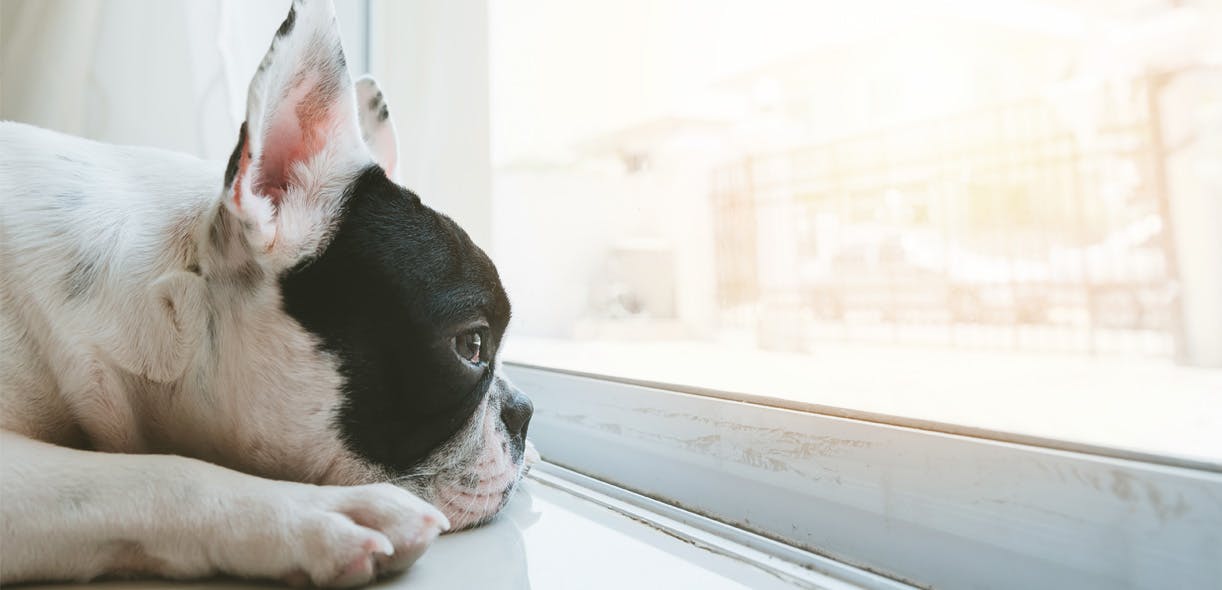Luna is a playful dog with big blue eyes. The couple who adopted her fell deeply in love with her and had all the right intentions. In their presence, the Husky cross was calm and affectionate but the moment Luna was left alone she would howl, pee on the floor and chew furniture. When the couple had their baby, it was time to read the writing on the wall: Luna required more attention than they could give. They made the wrenching decision to entrust her to the SPCA in Montreal where, according to the latest reports, she’s still in foster care, waiting to be adopted.

Luna demonstrates all the symptoms of separation anxiety. According to one study, 30% of shelter dogs were abandoned for the same reasons: when left alone, they urinate or defecate (often by the front door), destroy objects and furniture, harm themselves, vocalize and/or hyperventilate. “They have a phobia about being left alone,” says Amélie Martel, animal welfare director at the SPCA in Montreal.
Get the right diagnosis
Beware: the fact that your dog displays these kinds of behaviour doesn’t necessarily mean that he or she is suffering from separation anxiety. A dog with a urinary infection may be unable to wait long periods to pee. A dog that barks when you’re away may just be reacting to a noise next door. And a dog that sticks to you like glue may be suffering from hyper-attachment, which doesn’t mean that he’ll automatically experience anxiety when you leave home without him. To get the right diagnosis, it’s best to consult a vet.

Taken individually, each of these types of behaviour can have other root causes. An animal health professional will be able to analyze the overarching symptoms and check that they don’t stem from a medical condition. To correctly diagnose the situation, they may ask you to film your animal while you’re away.” — Amélie Martel, animal welfare director at the SPCA in Montreal.
Separation anxiety can be caused by several factors. A dog may be genetically predisposed to it or may have been abandoned. Something as basic as a change in your dog’s routine can be a trigger—whether it’s a move, a separation, a death, the arrival of a baby or even back-to-school season. “Frequently people adopt an animal at the beginning of the summer and take it everywhere with them for a couple of sunny months. When it’s time to go back to school or work, the dog is left alone for the first time and may be unable to adapt to its new circumstances,” says Martel.

Treatment options to help dogs overcome their separation anxiety and phobia of being alone do exist. “It’s a long haul, though,” Martel specifies. Here are some pointers to help your animal get over his fears.
Avoid solo stays
As with all phobias, separation anxiety is an uncontrollable fear, in this case of being left alone. For the duration of treatment—whether it’s weeks, months, or even years in the most extreme cases—it’s best not to leave your dog alone. Take him to work with you, if you can. Or else, leave him with a friend or family member or take him to dog daycare during the day.
Consider medication
An anxiolytic medication can be an option to help calm your anxious canine. Think of this medication as more of a temporary crutch for the duration of treatment rather than a “miracle” solution.
Don’t accentuate the negative
As a reflex—and to avoid household destruction during their absence—some people will put their anxious dog in a cage while they’re away. This isn’t a good idea as it will actually increase the dog’s anxiety. When you teach your dog to avoid problematic behaviour (such as barking), this doesn’t mean that you’ve cured his phobia. The phobia may resurface in another form, such as loss of appetite.
Teach independence
Some games are designed to help animals appreciate being alone. For example, a ball which distributes treats may gradually teach your dog to accept your absence. Or try filling a cone with frozen (so it lasts longer) peanut butter, and exiting the room where you’ve put the cone. This will give your dog the choice between staying at your side or being by himself and getting a tempting reward. It will also help him learn to spend more time alone without that situation being associated with negative emotions. With time, you’ll be able to start leaving him—for short periods to begin with, then for longer stretches—without your dog feeling abandoned.
Photo 1: Luna has been waiting since last winter to be adopted.
Photo 2: Separation anxiety can be caused by several factors.
Photo 3: Treatment options to help dogs overcome their separation anxiety do exist.
